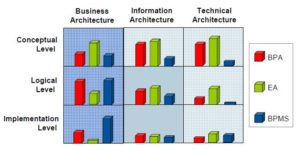Michelle Lagna of JPMorgan Chase, a Pegasystems customer, gave a presentation on their CoE as one of the solution providers sessions. Their CoE focuses on the use of BPM tools (primarily Pegasystems) to support their 30+ active systems. It was instrumental in allowing them to break down the departmental silos within the organization, establishing standard governance models, standardizing training and contributing to reusable assets.
The CoE supports all lines of business in planning and implementing BPM initiatives:
- Creating and maintaining architectural standards
- Centralizing and formalizing the housing and reuse of business-configurable assets
- Promoting standard methodologies, tools and education
They use the Agile development methodology (and promote and educate on Agile across the organization), and believe that it is instrumental to their success by reducing time to market and aligning business and IT. They’ve made a gradual transition from waterfall to Agile in order to ease into the new methodology.
They’ve developed a standard engagement model (unfortunately depicted on the presentation slide in micro-print and low contrast colors):
- Operational walkthrough and end-to-end review, including identification of process improvements and ROI
- Impact analysis review, identifying execution gaps and automated solutions, plus IT and business sizing
- Project initiation training, including both BPM and Agile training
- Application profile, high level use case requirements and reusable asset review
- Project setup and design review, including identifying assets leveraged from other projects, functionality specifications and a design compliance review
- Environment build-out, including generating a base framework
- Bootstrap session, which equips the project team to complete use cases on their own
- Direct capture of objectives to elaborate use cases, design specifications and traceability matrix; this is specifically assisted by the Pega project
- Identification of reusable assets, then harvesting those assets and making them available for reuse by other projects
The CoE is heavily involved in the early phases, but by the time that they get halfway through the project, the project team is running on their own and the CoE is just checking in occasionally to make sure that things are proceeding as planned, and to help resolve any issues. They had to make some organizational changes to ensure that the CoE is engaged at the right time and that siloed solutions are avoided.
She presented some of the key benefits provided by the CoE:
- Common class structure for reusability
- Library of reusable assets with tools to track usage
- Standardized engagement model, including a “Perfect Start” training and certification stage
- Monthly educational webcast
- Improved release planning process (which I’ve seen listed as a key benefit of a CoE at other customers that use other BPM products)
- Allowing for faster changes to improve business agility
The CoE has been backed by senior executive sponsors within JPMC, which has been key to its acceptance. They are run (and funded) as a shared service, so there are normally no direct chargebacks to the projects unless the CoE team is required to be onsite for an extended period of time due to a rush or urgent situation. Interestingly, the CoE is not all co-located: there are five offshore development resources that handle harvesting the reusable assets, although they are managed from an onshore resource.
Great case study, and a lot of material that is of use regardless of which BPM product that you’re using.








